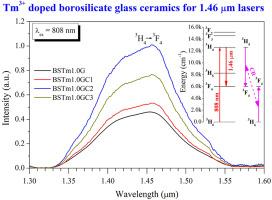用于可见光和近红外激光器的掺 Tm3+ CaF2 氧氟硼硅玻璃和玻璃陶瓷
IF 3.3
3区 物理与天体物理
Q2 OPTICS
引用次数: 0
摘要
讨论了掺杂 Tm3+ 的 CaF2 基氧氟硼硅玻璃和玻璃陶瓷的结构和发光特性。临界玻璃陶瓷(BSTm1.0GC2)的性质是通过 450 °C 1 小时的不同热处理工艺获得的,Tm3+ 离子的浓度优化为 1.0 mol%,以实现高效发射。采用标准的 Judd-Ofelt 理论对光谱和激光特性参数进行了评估。通过 360 nm 紫外波长的激发,研究了通过 1D2 → 3F4 转变发射蓝光的情况。在 808 nm 激光激发下,玻璃和玻璃陶瓷通过 3H4 → 3F4 转变产生 1.46 μm 的发射。BSTm1.0GC2 的有效带宽(114.99 nm)、受激发射截面(14.30 × 10-21 cm2)、增益带宽(1644.74 × 10-28 cm3)、优点系数(10.21 × 10-24 cm2s)和 3H4 → 3F4 转变的量子产率(76 %)使其适合作为 1.46 μm 近红外光纤激光器应用的增益介质。本文章由计算机程序翻译,如有差异,请以英文原文为准。

Tm3+ doped CaF2 based oxyfluroborosilicate glasses and glass ceramics for visible and NIR lasers
The structural and luminescence properties of Tm3+ doped CaF2 based oxyfluoroborosilicate glasses and glass ceramics were discussed. The critical glass ceramic (BSTm1.0GC2) nature was obtained through different heat treatment processes as 450 °C for 1 h and the concentration of Tm3+ ions was optimized as 1.0 mol% for efficient emission. The spectroscopic and laser characteristic parameters were evaluated applying the standard Judd-Ofelt theory. The emission of blue light through 1D2 → 3F4 transition was studied by exciting at 360 nm UV wavelength. Upon 808 nm laser excitation, the glasses and glass ceramics produce 1.46 μm emission through 3H4 → 3F4 transition. The effective bandwidth (114.99 nm), stimulated emission cross-section (14.30 × 10−21 cm2), gain bandwidth (1644.74 × 10−28 cm3), figure of merit (10.21 × 10−24 cm2s) and the quantum yield (76 %) of 3H4 → 3F4 transition made the BSTm1.0GC2 suitable as gain medium for 1.46 μm NIR fiber laser applications.
求助全文
通过发布文献求助,成功后即可免费获取论文全文。
去求助
来源期刊

Journal of Luminescence
物理-光学
CiteScore
6.70
自引率
13.90%
发文量
850
审稿时长
3.8 months
期刊介绍:
The purpose of the Journal of Luminescence is to provide a means of communication between scientists in different disciplines who share a common interest in the electronic excited states of molecular, ionic and covalent systems, whether crystalline, amorphous, or liquid.
We invite original papers and reviews on such subjects as: exciton and polariton dynamics, dynamics of localized excited states, energy and charge transport in ordered and disordered systems, radiative and non-radiative recombination, relaxation processes, vibronic interactions in electronic excited states, photochemistry in condensed systems, excited state resonance, double resonance, spin dynamics, selective excitation spectroscopy, hole burning, coherent processes in excited states, (e.g. coherent optical transients, photon echoes, transient gratings), multiphoton processes, optical bistability, photochromism, and new techniques for the study of excited states. This list is not intended to be exhaustive. Papers in the traditional areas of optical spectroscopy (absorption, MCD, luminescence, Raman scattering) are welcome. Papers on applications (phosphors, scintillators, electro- and cathodo-luminescence, radiography, bioimaging, solar energy, energy conversion, etc.) are also welcome if they present results of scientific, rather than only technological interest. However, papers containing purely theoretical results, not related to phenomena in the excited states, as well as papers using luminescence spectroscopy to perform routine analytical chemistry or biochemistry procedures, are outside the scope of the journal. Some exceptions will be possible at the discretion of the editors.
 求助内容:
求助内容: 应助结果提醒方式:
应助结果提醒方式:


